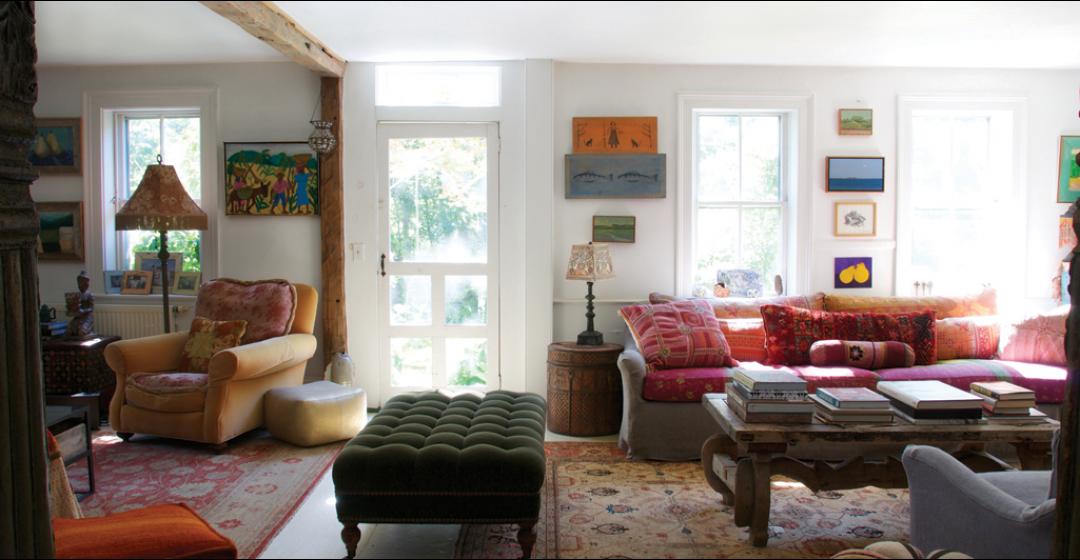“Fair Oaks” is a misnomer. Perhaps 150 or 200 years ago, when the property was new, the oaks were fair. Now they dip, they soar, they meander, sending out thick, leafy tentacles from gnarled fat trunks. One branch is so long and ponderous, it’s supported by the trunk of another tree.
In short, the oaks are now spectacular – as is the estate that shares their name. On a quiet stretch of North Road, just beyond Seven Gates in Chilmark, the white, sprawling farmhouse is shaded by two generous trees and surrounded by ancient stone walls and lush, colorful flora.
The house, a two-story patchwork of rooms that radiate from the kitchen/dining area, is thought to have been built around 1850, based on published records and the dates of newspapers found in the walls during a renovation. It was purchased in 1902 by George Cavanagh, a Boston contractor who came to the Island to create Menemsha Harbor from Menemsha Creek. His son Dr. Charles Cavanagh and wife Elizabeth inherited the property, and later deeded it to one of their children, Gertrude Matz. She parceled out two hunks of land, one to nephew Robert Cavanagh and another to niece Ann Cavanagh Sutherland and husband Jack Sutherland. The rest of the property – save a generous acre – was sold off piecemeal. Matz maintained Fair Oaks until her death in 1981. It changed hands in 1986, and was sold to current owner Tamara Weiss ten years later.
Some of the property’s history is sketchy. Weiss, part-owner of the homeware and clothing store Midnight Farm in Vineyard Haven, chuckles as she explains. “Ann Sutherland [who grew up in the house and now lives next door] told me, ‘There are many stories and probably none of them are true.’”
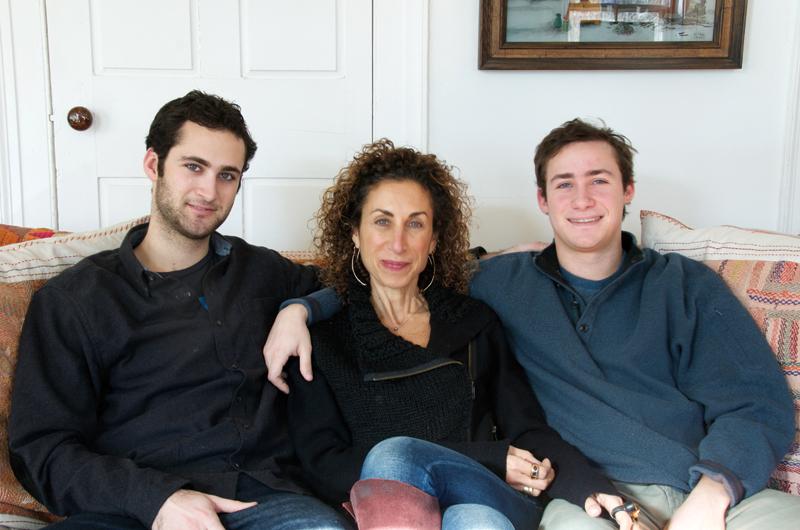
One debunked tale was that the property was, at one time, a horse farm. Sutherland, in a phone interview, addressed the issue. “It was never a horse farm,” she insisted. “My aunt had a horse.”
The house may or may not have been at some point Kephigan (Cape Higgon) School, and it may or may not have been part of neighboring Seven Gates Farm. What is definitely true is that there was a structure that served tea, sandwiches, and cigars. In 1932, Matz and her husband Edward built Fair Oaks Tea and Sandwiches on the land adjacent to Fair Oaks that subsequently became Ann and Jack Sutherland’s property.
Weiss recalls how she and husband Gary Stuber (the two are now separated, but remain good friends) came to land in this idyllic spot. In the late 1990s they were living in Tribeca in New York City with their twin baby boys and considering a move to Martha’s Vineyard. “At a certain point,” Weiss says, “Gary and I just looked at each other and said, ‘We can’t raise our kids in the city.’ We needed some grass and sun and ocean and trees.”
Born in Western Massachusetts and formerly a restaurateur in the Berkshires, Stuber favored small-town living over metropolitan. “I found I had nothing to teach [the boys] about New York, not being a city human,” he explains. “I had nothing to impart to toddlers about living in the city. We were constantly back and forth from New York to the Vineyard anyway, so we decided, why wouldn’t we move?”
When a friend mailed them a picture of Fair Oaks with the comment, “This looks like a nice house for sale,” they set out for the Island with all due speed. Weiss still gushes when she describes her first impression. “It was the first house we looked at,” she says. “We just looked at the front of the house, with stone walls all around it, and saw the oak trees sweeping down and it was magical. The hydrangeas, the lilacs, the honeysuckle, the wisteria, the hemlock, the two huge holly trees in the back, the two chestnut trees that must be hundreds of years old – before we even walked in I said, ‘This is it.’”
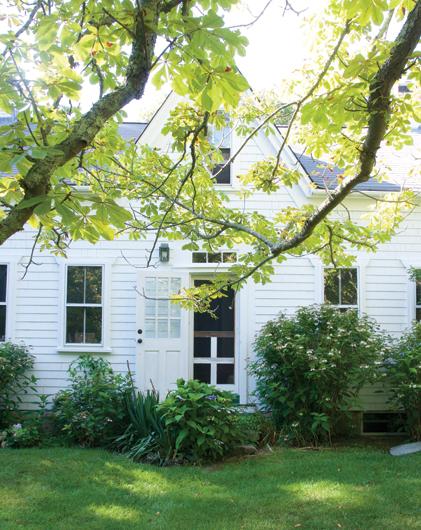
Both Weiss and Stuber, a private chef and builder, already had long-term ties to the Island. Weiss’s parents came to the Island on their honeymoon in the mid-fifties and decided to buy a summer home off Lighthouse Road. “I was an up-Island girl,” she recalls. “My first job was at the Aquinnah Shop with Anne Vanderhoop. She taught me everything about business.” Stuber, meanwhile, came in the mid-eighties after closing his restaurant in the Berkshires to work as a set designer and builder for Island Children’s Theatre.
The couple met and married on the Island, then settled in a repurposed paper bag factory in New York. Stuber opened a lighting design studio in Brooklyn. Weiss enjoyed some success as a filmmaker and had various jobs in the music industry, but ultimately found she excelled in producing pop-up events showcasing the work of artist friends. “We decided,” she says, “to move back to the Island and open a store.”
Before moving a small family in, the house needed to be softened and winterized. The former owner was an interior designer from Malibu with a Shaker approach to the property. “It was very stark,” Stuber recalls. “Very designy. She believed in a pure architectural form. It was slightly sterilized.”
With Stuber’s design sense and carpentry skills and Weiss’s sense of style, the home became summer-pleasing and winter-cozy. One only needs to step into Midnight Farm to sample Weiss’s feel for aesthetics. “I love vintage textiles and fabric and color and old wood,” she declares. She carries the same eclectic sensibilities into the decorating of Fair Oaks, and both she and Stuber are longtime fans of “reuse and repurpose.”
They created a sub-kitchen from an old harness shed, enclosed a porch, and added a dining room, bedroom, and basement, using primarily recycled materials – many from the house itself. When renovating the kitchen, Stuber used the weathered cedar exterior finish boards from the renovation of a Lucy Vincent house to sheathe the interior of the sub-kitchen. A state-of-the-art Viking range was gifted from another kitchen renovation. Two columns in the dining room were originally part of an old theater in Prague.
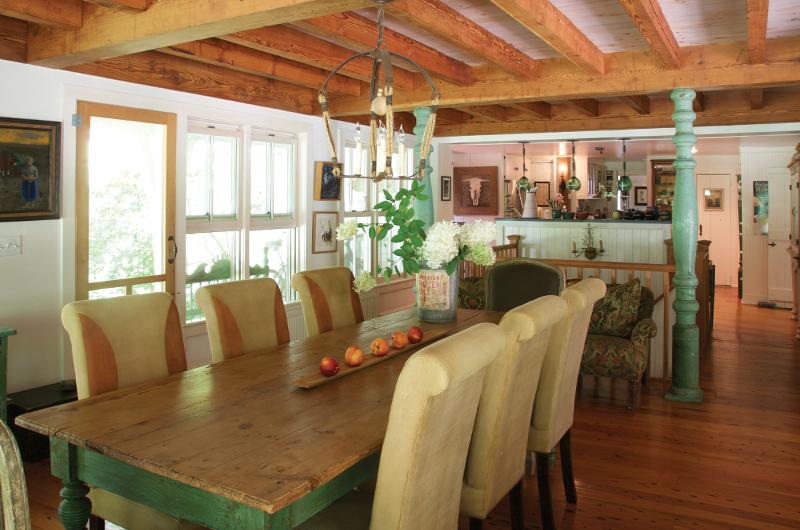
“This…” – Weiss sweeps a graceful hand across a large, rectangular great room with fireplaces on opposing short walls – “used to be two birthing rooms. They gave birth in these rooms because of the fireplaces. They were the warmest rooms in the house. We combined them.”
Stuber once found a green paneled and arched door at the dump. Weiss recalls their conversation when he brought it home. “What is that?” she asked. “I don’t know,” he replied. “Outside shower?” A fish-shaped handle from Weiss’s shop completed the theme.
“One thing that I would call unusual or funky about my house,” she says, “is that it’s full of reclaimed things, parts from other houses, wood from jobs that Gary worked on as a designer/carpenter – things that were discarded and we could reuse with a little love and make whole again.”
And then there’s the four-foot-long soapstone sink in the kitchen, which came from a property where Weiss was doing interior design work. “The story goes,” says Stuber, “that it originally had a hand pump.” Stripped and refitted with a commercial faucet by the previous owner, it’s the first thing seen when entering the home. It and a funky cobbled-together cabinet dominate the space renovated for a private chef and a woman who loves to entertain. A long, rustic farm table from New Mexico fills the attached dining room.
Although the renovations are finished, the home remains a work in progress. If a piece of furniture or other decorative item arrives broken at Midnight Farm and the shipper doesn’t want it back, it will often find a home at Fair Oaks. “It’s very helpful to have someone like Gary to patch things together,” Weiss says. A lot of the outside also comes in. “We have a huge collection of heart-shaped rocks that we’ve collected over the years,” she explains. “To this day, when anybody goes to the beach, our heads are down. If I find a bird’s nest, I’m happy to take it and stick it on a shelf. There’s nothing more beautiful.”
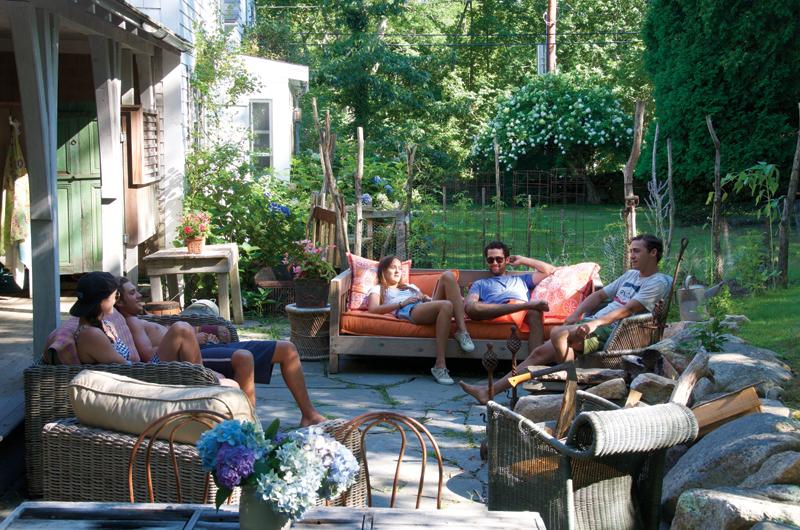
The kitchen and dining room, with state-of-the-art appliances and chef-quality design, lend themselves to entertaining. Weiss admits that before she and Stuber separated, they had spectacular dinner parties. Now the soirées continue, but in a different form. “Honest truth?” she laughs. “We used to have lots and lots of dinners. Gary was an incredible cook. But now, unless you just want to have kale salad, it’s potluck. It’s a way that I’ve gotten used to entertaining since I’ve been on the Island, even when Gary was cooking. I really love it. People go out of their way to create incredible food.” Even in the heat and rush of summer, friends create such magical dishes, to the point that nearly fourteen years ago Weiss created a successful cookbook of their recipes: Potluck at Midnight Farm.
Family dinners, on the other hand, tend to be more simple – greens from the garden and perhaps a fish speared by one of the boys. Twin sons Noah and Jules, seniors in college, spend their summers at Fair Oaks. They’ve picked up the entertaining bug, but prefer the outdoors. “The kids like to hang out here,” she says. “Their friends come over here, which I love. They built a little reclaimed fire pit outside. They play a lot of music and make a fire a couple times a week in the summer. It’s lovely.”
Although the house and trees have evolved and expanded over the years, the acreage has shrunk. Originally some 180-plus acres that crossed North Road and encompassed much of what is now the Land Bank property at Waskosim’s Rock, the plot is now shy of two acres. But the ancient stone walls remain and blooming flora fill the area with color and fragrance. In the quieter moments, Weiss enjoys viewing the outdoors through her living room window. She’s especially fond of the lilacs that bloom in June. “It’s purple fire,” she says.
And, of course, there are the oak trees – bigger than life, and much more than fair.

